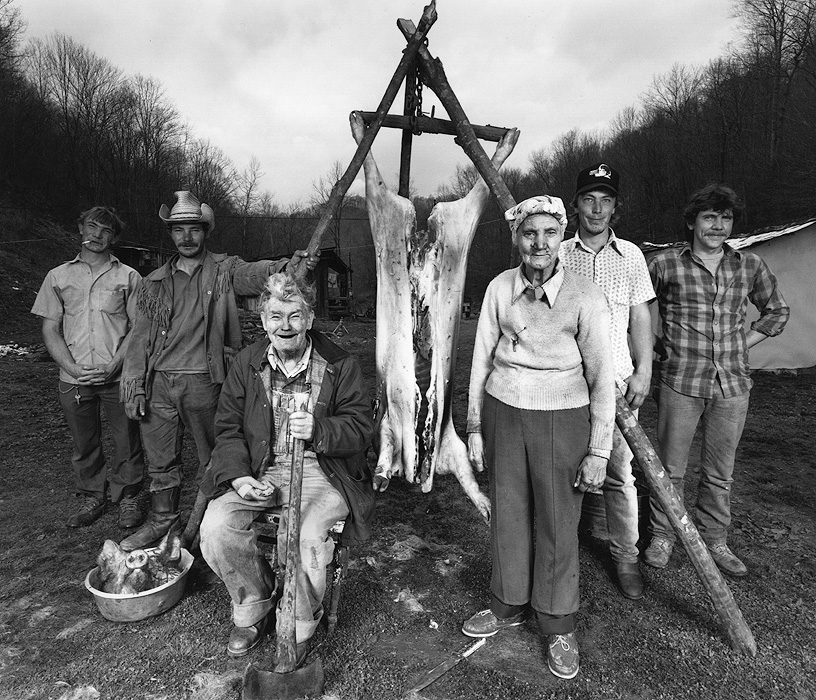
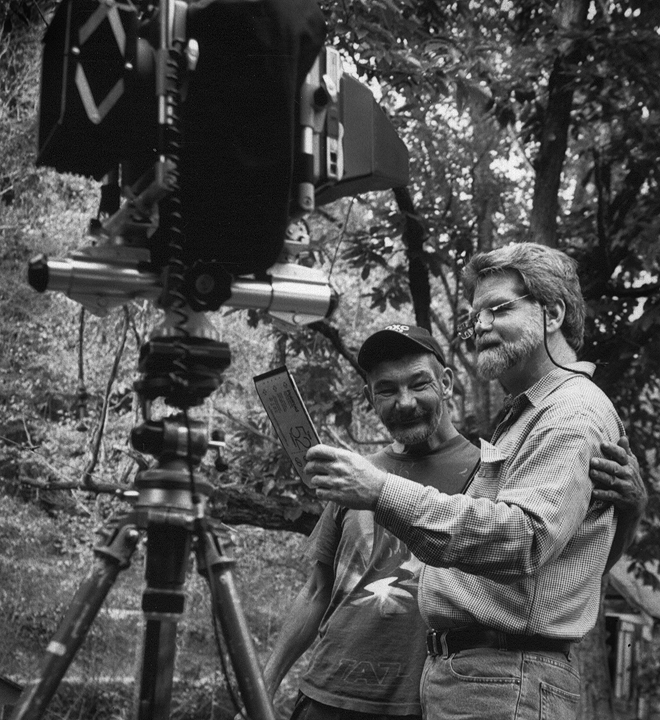
Above: James Napier and Shelby
Steve Huff/Shelby Lee Adams interview – August 2010
Today I would like to bring you an all new Featured Photographer interview! This interview is with Shelby Lee Adams, a photographer who is most known for his Appalachian Portraits featuring the families who live in the mountains of Kentucky. He is also a Photography Guggenheim Fellow for 2010-2011 and I am honored to feature him on my website.
While some see his work as controversial, I see it as important documentary work that not only shows the skill of Shelby as a photographer and his passion for the art, but it also shows us a slice of life that many of us do not even know exists. I am a big fan of his work and it is my pleasure to bring this interview to you today. After reading the interview, be sure to visit Shelby’s website/blog that features more of his work. Please note that Shelby does not spend much time on a computer and is always traveling. Therefore, he will most likely not respond to any questions in the comments.
Also, his book “Appalachian Lives” can be bought at Amazon.com. Highly recommended!
—————————
The Interview
Steve: Hi Shelby! First I want to say a big THANK YOU for agreeing to do this interview with me. I am a big fan of your work and I feel connected to it mainly because my Father was born and raised in the mountains of Kentucky where many of your photos were taken. When I was young we would visit the mountains and I always felt a sense of peace with it. The people were always friendly, always happy and seemed to enjoy their life even though it was much different than the life i was living in the big city of Chicago. Your photos take me back to those times and the stories you include with these photos really show me that not much has changed up in those mountains over the past 30 years and I find your portraits to be exceptional! So with that said, let’s get started!
How old were you when you first found an interest in photography, and what were your subjects when you first started out?
Shelby: Being an only child I received a lot more encouragement perhaps, I was drawing and painting at age five, studying art books that my mother and grandmother provided, working with oil paints and canvas before age 10. I was actually born in the town of Hazard, Kentucky and raised in an adjoining county called Letcher. I won the only art award in my high school class in 1968, not very competitive then. We did not have photography. After a year of floundering in college, I was accepted and attended the Cleveland Institute of Art in 1969. As a painting major, upon taking my first photography class in my second year of art school, I was 19 years old; I practically changed my major immediately to photography. My first photographic subject’s were my mother’s parents, my grandpa and grandma Banks and my maiden aunt Glade who was my childhood nanny. They owned a huge farm in a hollow called Johnson’s Fork in Eastern Kentucky where I was raised and they were all born. There was livestock and wild animals, farmland and mountains, creeks and ponds; all kinds of natural space for a child to play and grow up on, observe, draw and paint and later photograph.
On a deeper level, from the ages of 9 – 12 years old my grandma suffered from an eye disease that caused her to go totally blind within that 4-year period. We were very close. She encouraged my drawing and painting and it was “because of her” struggle that I committed myself to the visual arts. From that early childhood experience, I developed a strong belief in the visual arts as a transforming tool to help heal and uplift ones spirits, to inspire others too live a fuller life, no matter how difficult the situation. For me art and photography are a committed discipline and field of study.
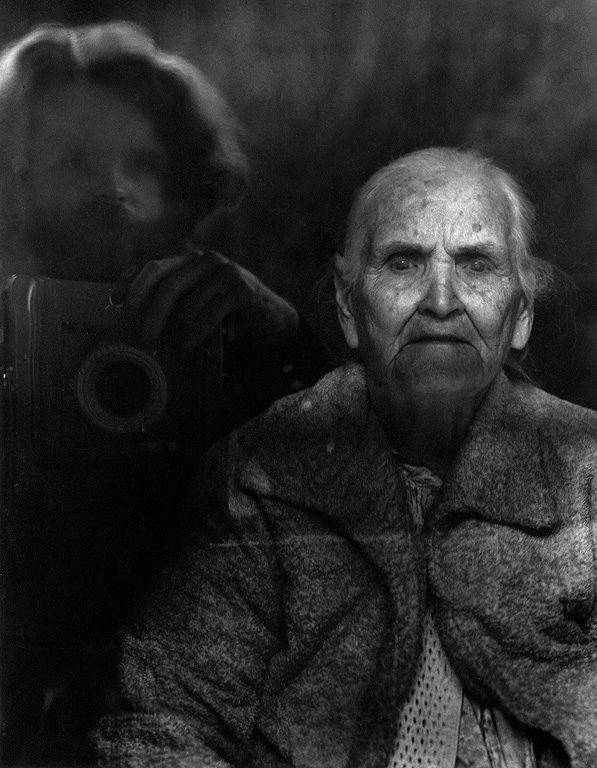
ABOVE: Self-Portrait with Grandma, 1974
Steve: What was the first picture you took that you were really proud of?
Shelby: Probably “Self-Portrait with Grandma,” 1974
Steve: When did you start photographing for your Appalachian project and how did you approach the families to let them know you wanted to photograph them?
Shelby: In 1974 I started using a view camera. I grew up in the “War on Poverty” era when Appalachia was in the news daily. My community had been photographed and filmed a lot by the media, some people felt shamed by this exposure. Mountain people were generally suspicious of the media and photography, including myself. My first attempts with photography were with a 35MM camera as a student, one spring I took a 4×5 view camera and boxes of Polaroid’s home to KY to photograph with, folks responded openly, not guarded, they liked seeing and getting to keep instant Polaroid’s right away. Their enthusiasm was amazing to me. This changed my approach to photography in 1974 and was the beginning of my serious work, a more formal approach, but more appropriate for my culture. I always ask people to make photographs with me showing them the Polaroid’s as we make pictures and then I always bring back photographs to give and share with my families before making new pictures. Sometimes it is a full year between visits, but this is a very important responsibility, to return with pictures, to affirm what you are doing and then continue. In my high school days my uncle, “Doc Adams,” took me around with him making house calls, driving into the heads of the hollers. These experiences happened before I was interested in photography. He taught me a lot about mountain people, they loved and respected him and this world and its people immediately fascinated me. My uncle “Doc Adams” opened a door for me that would last a lifetime.
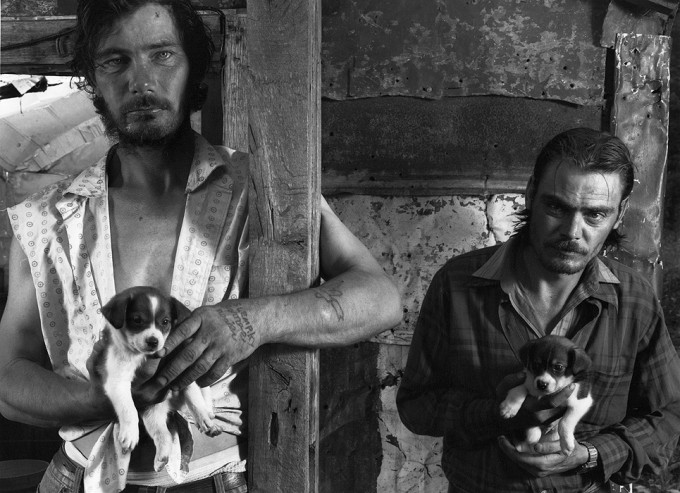
Above: Napier Brother’s with puppies
Steve: For the black and white portraits, what equipment did you use for the older photos, and do you still use that same equipment today?
Shelby: I started with a 4×5 Calumet student camera and soon advanced to a 5×7 Deardorff Field camera with a 4×5 reducing back. Later in the 80’s as my work became more complex, using more lighting equipment and various lenses, I purchased a more flexible Linhof bi-system view camera with a rear reflex viewer. With the reflex viewer I no longer needed a black viewing cloth that is common to view cameras and with this viewer you are not separated from your subjects visually. This is important in getting people comfortable and having good communications. I still use the Linhof today but have had other custom modifications made to this camera. For 35MM, I have always worked with Nikon’s and have always used Kodak Kodachrome 35MM film for my color work. Always documenting my sessions photographing and I have always made snap shots for my friends and subjects. Later changing to digital color when Kodachrome was no longer manufactured. My 4×5 black and white work has always been my standard forte for exhibitions and publications and most popular with my subjects. The film I used for most of my career I saw demonstrated by Bruce Davidson in a workshop in Ohio in the 70’s. He used Tri-X Pan Professional film packs. This was a 16-exposure 4×5 film pack that could be changed in daylight. The negatives are on a thin film base and delicate, the quality it produces is wonderful, but this film has to be printed through a glass negative carrier and handled carefully. All my negatives have been manually processed. When Kodak announced discontinuing this film pack in the 90’s I bought a freezer full and used until just recently. Now even 4×5 film holders are rare and discontinued, but I have a good supply and Ilford today makes a good 4×5 film and Fuji makes an excellent instant 4×5 print film. Further, now also working with CF memory cards, who would have “thunk it”?
Steve: One of your images that really sticks in my head is the one titled “The Hog Killing” – Is there a story behind this image?
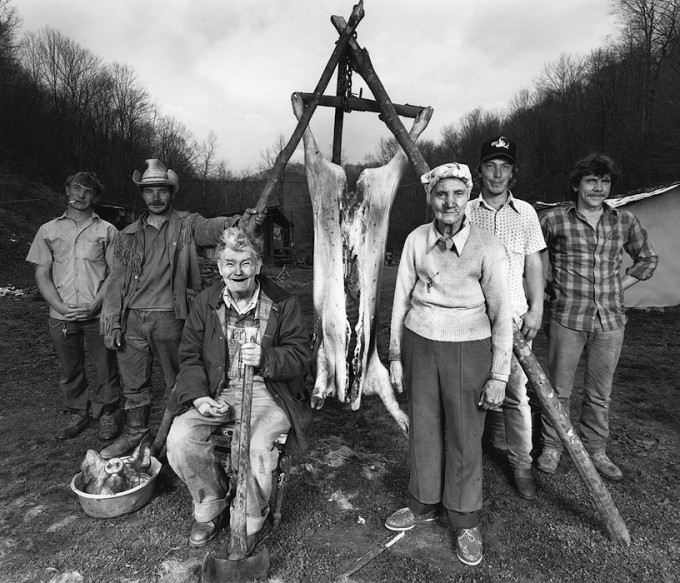
Above: The Hog Killing, Spring 1990
Shelby: When the Hog killing was made I was Head of the photography program at Salem State College in Massachusetts, then living in Salem, Mass. I always call and keep in touch with my friends in Kentucky throughout the year. During Christmas of 89 I had started talking to my friends about making a hog-killing photograph. My friend a preacher Wayne Riddle suggested the Napier Family as a good family to work with in making this photograph. He said, “They kill hogs the old timey’ way.” We both knew them and I had been photographing and visiting them for at least 5 years then. It should be noted that I have been photographing seriously in this area spending 2 to 3 months each year, some years trips made shorter, but for at least 6 weeks each time, ongoing for now 36 years. Everyone knows me in the community.
The idea and concept for this picture and many of my photographs comes from my Appalachian childhood memories. I write and sketch in my notebooks throughout the winter, when an idea comes and really excites me I call my friends and we discuss. Sometimes my Kentucky friends call me with their ideas. I consider this a collaborative relationship; some photographs materialize this way, from our sharing stories and discussing what is happening currently in the hollers. An important concern is to make pictures of people who have lived this life. Each person in “The Hog Killing,” photograph of that spring in 1990 had multiple experiences from childhood and throughout their lives of hog killings as a part of their natural life and means to survive. John Napier the man seated in the front of photo reminded us, we should hang the hog from a tripod wood frame like he had always done and his son’s volunteered and constructed this tripod frame, something they had done many times. For those not familiar with this ritual, a hog killing is usually an all day affair that utilizes every part of the animal in preparing months of food for a large family, other domesticated animals and the making of bi-products like soap. This photograph actually illustrates the middle of the process when the meat is cleaned, washed and ready to be cut into sections, to make pork chops and ribs; even the head in the pan is saved to be prepared for cooking later. Harry Crews has written an excellent book about the ritual of hog killings called, “A Childhood, The Biography of a Place”.
My early personal experience with this ritual was from my grandpa’s farm in Letcher County. From my childhood memories, this was the most exciting day of the year, up before daylight, making fires, boiling water, the crack of the gun shot, the smells, watching the men work so fast cutting the meat, hearing the sounds the knives made, scalding the hair off the animal and watching water and blood mix and the steam rise, all fascinating. Eating fresh made cracklings later was rewarding and delicious. The woman made soap from the fat, prepared hams and souse while preserving yet other meats. Everything was utilized in some manner. Mountain people consider this a joyous occasion and it is often a community event. If ill will had sprang up between neighbors during the year, on this day-the giving of meat to that neighbor renewed friendships and made solidarity. All of us in this group shared these same life experiences around hog killings.
Even in 1990 in Beehive, Kentucky we discussed the fact that this ritual was changing and disappearing from our culture. So everyone was excited about this day, to have me photograph something that we consider important and disappearing from our culture. This was the mindset before and during the making of the photograph, I volunteered to buy a hog, if someone could get it delivered to the Napier farm in Beehive.
In the mean time I had Spring break coming up at my college job in Massachusetts and I asked two students to join me for the week. We brought two video cameras for the students to film the event. When we arrived and settled in we ask Wayne to find a hog and bring it to the Napier’s. He priced a hog at $150.00 and I gave Wayne the money. He was to bring the animal in his pick up truck on a specified day. We all agreed that the meat would be equally divided between the Riddle and Napier families after the photo shoot. This would provide both families with meat for their homes for probably three months.
The day of the hog killing I was lucky, weather was cool and slightly overcast. I had chosen a 90MM Schneider lens to fit my 4×5 camera. I chose to use a Comet 2400-watt sec. pack for a flash lighting source to mix with the daylight. We set up two light stands with each holding a light with a silver umbrella; each light was powered with 1200 watts of light. I made a few Polaroid’s and light adjustments and we shot film immediately while I engaged everyone to look toward the camera. The entire shoot did not take 20 minutes. I remember the F-stop was F32, my usual aperture setting. The shutter speed and daylight reading was probably exposed at 1/60th or 1/125th of a second, with daylight being the dominant light source. We made 4 exposures on 4×5 film then doing one final Polaroid check print. This method of working I call previsualizing the image, working toward the goal of constructing the composition you have in your mind and making it happen. It can be quite chaotic working in this manner, watching some things just happen naturally and directing other elements together simultuiously. The photograph is always better or worse than you expect and always some surprising element is recorded that you did not plan or even see.
The public’s response to this photograph has been varied. Some see this picture as a valuable contribution to documenting this culture that is changing. Other’s say it is the vision of myself solely. Some say this is a staged photograph, implying that something is not real or false. I call my work formally posed with my subject’s full corporation, seeing and sharing Polaroid’s through out the process, affirm this. I have established long term relationships with these people who do trust me. The final result is of no surprise to any involved, the picture is what everyone worked together to make. Throughout the history of photography portraiture has been mostly formally posed using view cameras. The difference in my work is I’m taking the studio equipment on location to make the pictures in more specific environments, not just where the light is good, where my subjects are more comfortable and intimate, working with lenses and lighting tools that reflect my own esthetic sensitivity and vision and very importantly seeking out only authentic cultural representation from my subjects, something outsiders working here may not always understand. The plentifully history of the media here again is 35MM photojournalism working where the editing, cropping of photos and accompanying words are decided by a committee removed, not necessarily concerned about the people photographed, but more their message.
My pictures are sometimes recreations of events and yet still part of the people’s real lives lived today. It is my belief that ones memories and thoughts held inside contribute greatly to the making of engaging portraits. Nothing is staged or added to, out of context. In making “The Hog Killing’’ for example, I asked Jerry Napier [second in from right] to remove his Michel Jackson cap for the picture. He did so then he placed it back, saying “This feel more natural with my cap on.” That’s the way I took the picture. Today, cultural representation is a mix of the old and new generations in Appalachia, as in most other cultures. You cannot simulate too much one way or another or then it does become a staged picture. Then viewers raise the question of what should be represented from a culture? Some Appalachian’s are offended by this picture and there is a lot of shame within my culture, caused by media misrepresentations and stereotyping over the last 60 years. In part, my intentions are to help right that misunderstanding and those photographs and show what was real for the Napier’s of Beehive, Kentucky, my memories of my own and grandfather’s life, the Riddle Family, among other’s. Not to portray these people as some Hollywood movie set with props and dressed up actors is important. It is a thin line to perceive the difference sometimes, especially if you are on the outside of a culture. The media itself conditions us all to view things in a certain way and we are affected either unconsciously or consciously. I’ve always said my work was done as an insider, subjective, as a native artist searching his native roots with his subjects as his collaborators. How you view the work depends much upon your own life experiences.
At this writing in 2010, three of the six people in “The Hog Killing” photo are now deceased. Berthie and John Napier are both gone, [the elder couple in the center of photo]. This photograph represents for me a part of their cultural lifestyle authentically with one son in the background wearing a Michel Jackson cap. James another son [left] also recently deceased, I valued as one of my closest friends, as do many people who knew him. All people represented here told me they feel true to themselves and are happy with the out come of the picture produced that is very important to me. How the viewer processes images is independent of the photographer and his subjects. Yet, from years of sharing my work I now think even the viewer is more a part, serious photographs mirror back more connection than we think if we allow engagement. At exhibitions, over the years I’ve had people come up to me to express their gratitude to me for the making of this photograph. With tears in their eyes sometimes, because this photograph would deeply resonate within them-recalling their own childhood experiences from for example: Eastern Europe, The Czech Republic, Spain or Brazil and they would be so passionate to share these memories with me. More importantly viewers tell me this picture opens doors for them to share this experience with their own children, something they may not have been able to articulate before. From my experience and feedback I’ve received, “The Hog Killing” has become a catalyst for other cultures with similar background experience. Because this photograph opens up a map to common familiarity shared by many cultures universally. This is the reward of making what I call a primal photograph. Many cultures feel their problems are unique to their situations and their specific holler’s, I’ve learned we all have similar conditions and attributes. If we could openly share more with each other and be less defensive – we would all benefit more abundantly.
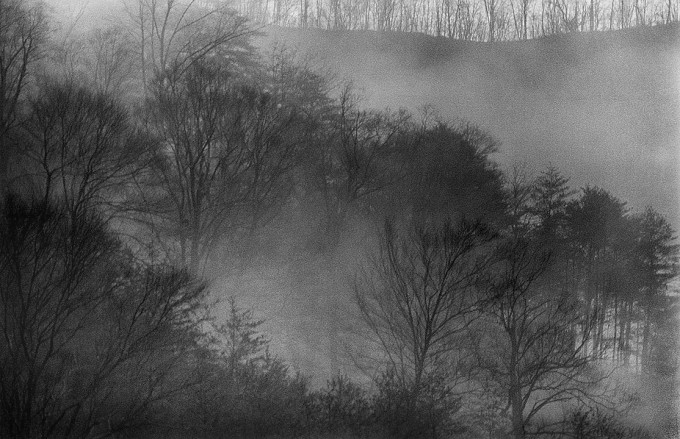
Above: Fog Lift
August 2010
All photographs and text copyrighted – © 2010 Shelby Lee Adams, if editing and changing format or text, please contact and consult author/photographer.
Forthcoming Workshops:
Environmental Portraiture, 1 week workshop, International Center of Photography, NYC, Approximate time – Mid August 2011 [annually], Ph. 212-857-0001 www.icp.org
Environmental Portraiture, 1 week class, New space Center for Photography, Portland, Oregon, Dates: July 25th – 29th, 2011
Ph. 503-963-1935 www.newspacephoto.org
Look for part two to this interview in the coming months. Thank you Shelby!
[ad#Adsense Blog Sq Embed Image]


thanks for this post. loved reading it.
Beautiful photos. thanks for sharing his works
I noticed that when taking the photo of his grandmother, Shelby did not use a lens that skewed the photo in the way that his photos of other KY natives are skewed. His grandmother looks like a down-to-earth, good, well-grounded country woman, and there is a lightness to her face. The other portraits are misshappen, as if taken in a fun-house mirror and the use of reshaping replaces the natural forthrightness of country people with a creepy feel. Stephen King should see these portraits.
You see my photography work is done with love and feelings, for I come from a feeling and emotional family and culture. I was taught that good and bad are relative, not right or wrong.
To say that some of my work is “skewed,” demonstrates an incomplete understanding of the depths of my approach. Everyone I photograph is not like my grandma; a couple of my images represent thieves and robbers or worse. To photograph everyone with the same lens would not be purposeful. That does not mean everyone I photograph with a wide-angle lens is negative either, or judging, quite the contrary. For, it is the enter person and place I’m trying to reveal and many of us are “balled up” inside with many neurosis’s or worse, both subject and viewer alike. My intentions are to reveal my feelings and my subject’s feelings, emotions and behaviors about them selves, and they are not all-wearing “a lightness to her face,” like my grandma, in fact, quite the opposite. Unfortunately a few are victims, wanting some support and attention. Acknowledging help heal people. No culture, anywhere represents a “total natural forthrightness,” for no society is perfect. I am trying to create a body of work representing all the holler people, before this society disappears.
My first book published in 1993, commissioned the nationally respected Appalachian writer Lee Smith to write an introduction, the book also has quotes by famous writers like Flannery O’Connor and William Faulkner. My photographs have been donated, purchased and collected by educational and art museum environments for now over 30 years, representing a singular focus of my intentions uplifting and transcending my culture into the “Art” world. Something I don’t think anyone has done before with the holler people, from the visual arts perspective. My most recent book forthcoming this fall quotes the Dalai Lama and John Milton, with many passages shared in common with my holler friends. Go to the art museums and view the great works of art. Michelangelo, El Greco and even more modern artist like Francis Bacon and Picasso and others, all inspiringly use distortion and perspective as a tool bending their subject’s position for positive and negative effects. The saints, our Lord and the devil himself are represented in these paintings, validating effective intimate communication showing some distortions while communicating to us the viewers – awe, hope, vulnerability, morality and inspiration.
I for one do not visit carnival shows with distorted mirrors, nor do I think of anyone in such a light. I do know that serious art often mirrors back what we often think of our true enter selves. Perhaps, we all should support and visit our great art museums more frequently, to help elevate our self-esteem and gain broader insights, stir inspiration and knowledge about ourselves in these uncertain economic times, to create and maintain a wide-ranging accepting perspective and viewpoint for all, that is what I’m attempting to do with my work. More and more, I hope you will find my work in the art museum environments.
Shelby Lee Adams
September 10, 2011
I simply love Shelby’s work thanks for a great interview.
Steve,
Thank you for the great Shelby Lee Adams interview. I also admire his work and purchased his first two books when they were published. I just purchased his book “Appalachian Lives” using your link.
Is it possible to get more information on the digital camera and lenses Shelby Lee Adams uses for his digital color work, especially his 2010 work? He went into great detail about his view camera and black and white work, but briefly touched on his digital color equipment. I find his color photographs to be among the most impressive and important images in photography. In asking about his color digital equipment, I am in no way overlooking the importance, meaning, and seriousness of the work of Shelby Lee Adams.
Thank you,
Mike Butorac
I like Mr Adams’ work. I’ve seen it in different sources over the years.
Steve,
Thanks for a fantastic and refreshing interview. I’ve been a fan of Shelby Lee Adams since my instructor in a photography course here in NYC introduced us to his work. And this article provides some very interesting insights into his thinking and his process. And of course it reaffirms that it’s that approach and process that yields such amazing photography. While it’s interesting that he uses a view camera, that’s not what makes these shots special. I’d even say that beyond a certain basic level of competence, it’s not his technical skills either (though I’m sure they are formidable). Rather, it’s his humanistic approach in which he takes time to develop real relationships with and understanding of his subjects. I didn’t know that these shots were so “posed,” but it does nothing at all to detract from their haunting beauty.
I’m looking forward to part 2!
Great new feature Steve – I look forward to reading more interviews.
This is an amazing interview. Thank you Steve and Shelby. I’ll be looking forward to more.
Shelby your photos are really wonderful. The photo of you and your Grandmother is just stunning.
I really really enjoy this post. i do share Fred’s point, this blog has become not just a regular camera gear review/discussion blog like everywhere else, but more of a true photography and photographers blog which is hard to find these days.
Good job. I think your blog is evolving in a very good way.
I adore B&W work with view cameras. Shelby Lee Adams’ work is beautiful. I like the realism. He has captured the history of these people, and became part of their family in that community.
Very nice. A modern day “Let us now Praise Famous Men”
beautiful in a creepy way, love the two men holding the puppies.
Amazing, amazing images, remind me of how far I have to go as a photographer. THese are remarkable. Congrats on the new feature!!!
I’ve been really looking forward to this interview ever since you first mentioned it. The images all hold such a fascinating intrigue, glimpses of a world few of us will ever see. Developing such a close relationship with the people you picture, over the span of time is serious dedication, but the results are unquestionable. The pictures are truly moving.
“For an artist, clarity is made into physical forms, in this case a photograph between conscious reality and unconcious feelings, hurts and needs. This photograph speaks with my interpretation to the meaning of authenticity; it is made with the subject’s awareness, cooperation and enthusiam. That is important to all my portrait photographs.” Shelby Lee Adams.
It really show in you images! Well done. Great work.
Interesting article. I just visited Shelby’s website, Amazing work! Photo’s that touched my heart!
Amazing post. Thanks for sharing it with us Steve and Shelby.